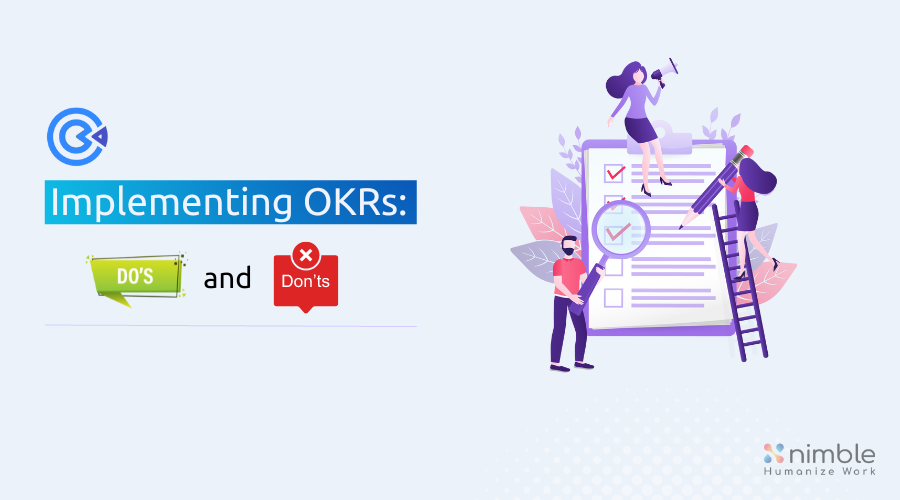OKRs vs. KPIs: Navigating the Metrics Maze – Differences, Examples, and Real-World Applications
Explore OKRs vs. KPIs: Uncover differences, examples, and real-world insights. Elevate your goal-setting and performance measurement strategies.
_____________________
_____________________

If you know the importance of setting and tracking OKRs, you may be wondering how exactly to implement them. Implementing OKRs is all about integrating objectives in the most effective way possible to receive the greatest outcome.
When it comes to your organization’s goals, “failure” isn’t a word you want to hear.
That’s why making sure you know how to successfully implement OKRs and avoid common mistakes is so important.
Let’s look at the most important steps you should take when implementing OKRs and which mistakes can negatively affect your results.
OKR stands for Objectives and Key Results.
OKR is a goal-setting methodology that helps your teams set and track measurable goals.
The objective is to align business, team, and individual goals for greater organizational clarity.
And how you implement OKRs and integrate them into your company based on these levels greatly impacts the outcome of your objectives.
The straight and simple: If you don’t track your results — no matter how good your OKRs are — they won’t help you improve!
Implementing OKRs is all about how you integrate and track OKRs within your organization.
OKR tracking involves accurately projecting and reporting on progress to ensure goals are being met on the individual, team, and organizational levels.
But without implementing the right steps, your tracking could be futile.
That’s why it’s key to follow the important “dos” and “don’ts” of implementing OKRs.
Do set the bar high enough to motivate your team, but not so high that failure is inevitable.
When we set our sights on something that’s too hard, it can be discouraging when we don’t reach it.
In other words, don’t set yourself up for failure by setting a goal that’s too easy or too hard.
Integrate OKRs into your business culture — from executives to individuals.
This’ll help ensure everyone understands the purpose of OKRs and how they work in conjunction with other systems and processes within your organization.
Want to know a secret about OKRs?
The success that you have with OKRs depends on collaboration and course corrections.
Most organizations need a collaborative system where people come together easily to make and receive updates on progress and make these corrections. Slack OKR software connects with your existing communication channels to streamline solutions and team collaboration.
It’s important to implement new systems on a step-by-step basis.
The last thing you want is to overwhelm people.
If you integrate systems too quickly without proper training, it can cause confusion which slows down productivity and can lead to issues meeting goals.
Evaluate what is working and what is not, then iterate improvements based on feedback.
This way you won’t waste time trying something out for months only for it to turn out poorly.
The process of evaluating an OKR cycle should be an opportunity to find ways to improve, so make sure you ask the right questions.
What worked well? What didn’t? What can you do differently next time?
You want everyone to understand what they’re doing, why it matters, and how to do it well.
And providing proper training means more than a basic overview of a system.
Instead, train team members on how they can get the most out of your OKR system and what tips and resources they need to be successful.
Make sure you have a designated leader for the OKR process.
Preferably someone with great facilitation skills who isn’t invested in the outcome, who doesn’t have a stake in any one result.
This leader will keep everyone on track throughout the process and facilitate retrospectives at the end of each cycle to evaluate progress.
If everything is important, nothing is!
Set priorities by looking at each objective individually, asking yourself how much traction it has gained since its creation, and whether or not it’s still relevant (or if there are other areas where more time should be spent instead).
If progress towards an objective’s key results and targets is slow or non-existent, consider removing it entirely or redefining its scope so that it focuses on a single specific area instead of spreading you thin.
If you’ve set up an OKR cycle and a Key Result isn’t hitting its objective, this is a big problem.
Make sure the KPIs are right and measure them in a way you can evaluate them properly.
And if there’s a Key Result that isn’t working, why let it stay?
Don’t let your company waste time and resources on something that doesn’t deliver.
Retrospectives are a great way to adjust course as you execute your strategy.
Reflect on what has happened over the last OKR cycle and ensure that lessons learned or improvements needed are taken into consideration going forward.
While goal setting is serious, it can also be fun.
It’s important to make interactions in meetings enjoyable — as well as the objectives themselves — so that people feel engaged with their work.
Consider incorporating games or activities into your meeting agenda.
Want a more engaging way to track progress?
Tally with pints, hearts, leafs, smileys, or whatever suits the objective and key result!
One of the most common mistakes teams make is setting only top-down objectives.
This puts people at risk of feeling like they’re being micromanaged.
You also don’t want to set objectives for individuals — that’s pitting people against each other and can jeopardize collaboration, communication, and connection.
Another common mistake is imposing targets for key results without consulting the people who have to achieve them.
This is a mistake because it will not be effective if everyone doesn’t agree with what they need to do and how achievable the goal is.
Don’t control a team or individual’s actions. Don’t tell them how to do their job.
Your role is to provide guidance and support and get out of their way so they can create and implement their own solutions. And you get the benefits of all their brain power, not just your own.
You want to ensure that your team is focused on their goals and help them to achieve them.
If you let meetings devolve into a series of recitations — just going through the motions, your team might feel disengaged and uninvolved — and that will defeat the entire purpose of using OKRs in the first place!
Don’t make your OKR process so complicated that nobody wants to bother updating their team on their weekly progress.
Keep it simple, but also make sure that you don’t miss anything important.
If someone has an idea that could help them reach their goal or make progress toward it, listen to them. Everyone has something they can contribute, so don’t shut down ideas before they even get started.
It’s easy to get excited about new systems and practices.
You’ll be tempted to dive right in — but beware!
It’s better to test your new set-up first than be overly confident with its results.
Make sure you check in regularly with all of your team members to see how they’re doing and if something isn’t working as intended.
If you don’t take time to reflect on how things are going, you won’t be able to improve them!
Use these meetings as a chance for team members to reflect on their achievements and failures to help them grow and better achieve their objectives.
Now you know that the key to successful OKR implementation is making sure you have the right systems in place and avoiding ineffective collaboration.
You want to involve your entire organization, align on progress, track results, and choose the best OKR software for your needs.
And remember that the process of implementing OKRs is iterative.
Tweaking goals and processes as needed is part of the deal.
It helps ensure you keep setting your organization up for success — so don’t feel like you need to nail everything down perfectly on day one!

OKRs 101
OKRs vs. KPIs: Navigating the Metrics Maze – Differences, Examples, and Real-World Applications
Explore OKRs vs. KPIs: Uncover differences, examples, and real-world insights. Elevate your goal-setting and performance measurement strategies.
What is an OKR goal? What is an OKR objective?
Implementing OKRs can be a great way for organizations to create organization-wide goals that keep motivation and alignment high, and in this post, you’ll learn more about this framework.
Tracking OKRs: Where the Real OKR Magic Happens
Implementing OKRs: 11 Do’s and 8 Don’ts for OKR Success
OKR Implementation Guide: 8 Tips to Ace Your OKRs
OKR Targets and Psychological Safety: At Odds or a Match Made in Heaven
SMART Goals or OKRs Targets for Motivational Power?
Join 150,000+ Pioneers, Leaders & Mavericks receiving our updates!

